Keep your small vegetable garden thriving by mixing clever strategies with a sprinkle of creativity! Encourage friendly insects like ladybugs that chow down on pests, or try companion planting—imagine those marigolds standing guard against aphids! Handpicking pesky bugs is like a treasure hunt, and using traps can be just as effective! Remember, healthy soil leads to stronger plants. Want to learn more fun details that’ll make your gardening experience even better? Just wait and see!
Understanding Common Pests in Vegetable Gardens
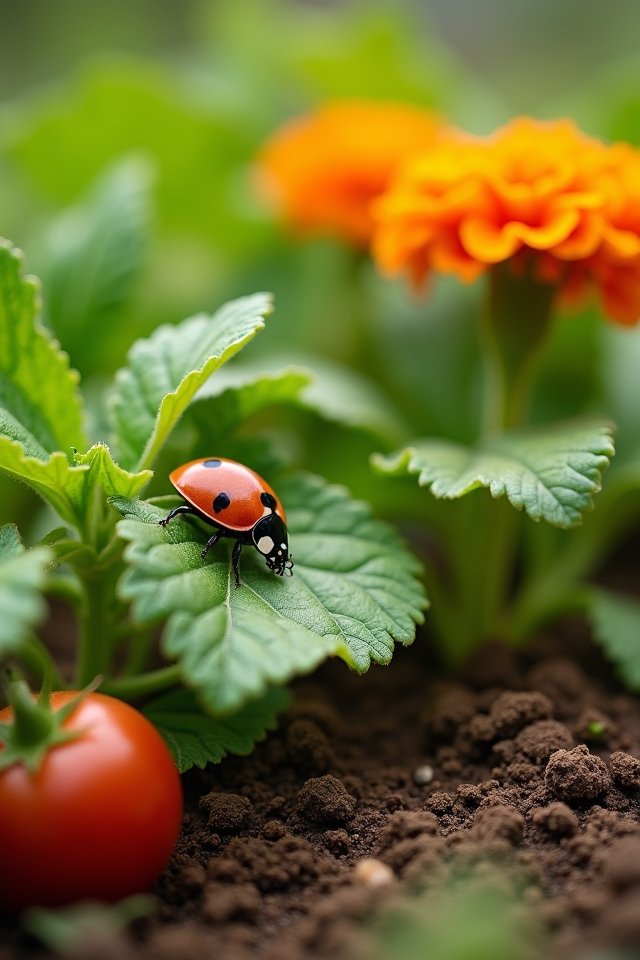
When you step into your vegetable garden, with its vibrant greens and sunny yellows, it feels like a paradise, doesn’t it? But lurking beneath those leaves can be pesky intruders! With effective pest identification techniques, you’ll spot trouble before it spirals out of control. For instance, monitoring aphid populations means understanding their life cycles—watch for those pesky eggs on your stems! Create a pest journal to track sightings; it’s like your garden’s detective story! Knowing when pests thrive helps you plan your defenses, making your veggie haven a fortress. Trust me, a little innovation can make all the difference! You’ll transform your garden into not just a haven for vegetables, but also a thriving ecosystem you’re proud to show off!
Natural Predators: Encouraging Beneficial Insects
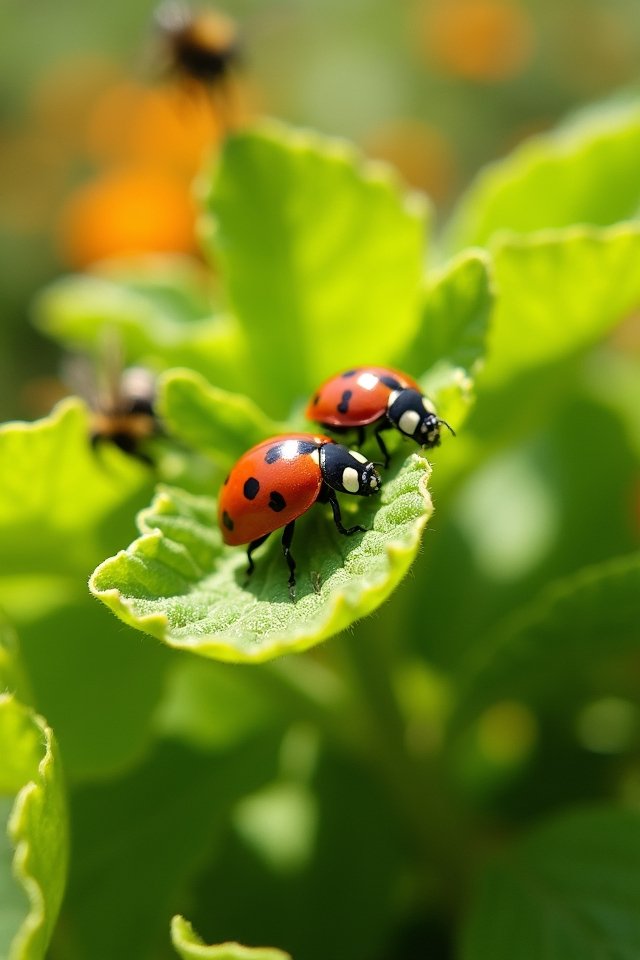
Those pesky pests you just learned about aren’t the only players in your garden drama! Enter beneficial insects, your garden’s tiny superheroes. Think ladybugs, lacewings, and parasitic wasps—these friendly fighters feast on aphids and caterpillars, helping you maintain a bountiful harvest. To attract them, consider habitat enhancement; a few flowering plants like marigolds, dill, or yarrow can create a buzzing oasis! Imagine watching them flutter around your lettuce, turning your garden into a vibrant show. Plus, these insects love a cozy home, so don’t forget to add shelter with diverse foliage. Why let pests rule the roost when you can invite the pros? With a bit of strategy, your garden can be both wildly beautiful and pest-free!
Handpicking Pests: A Manual Approach
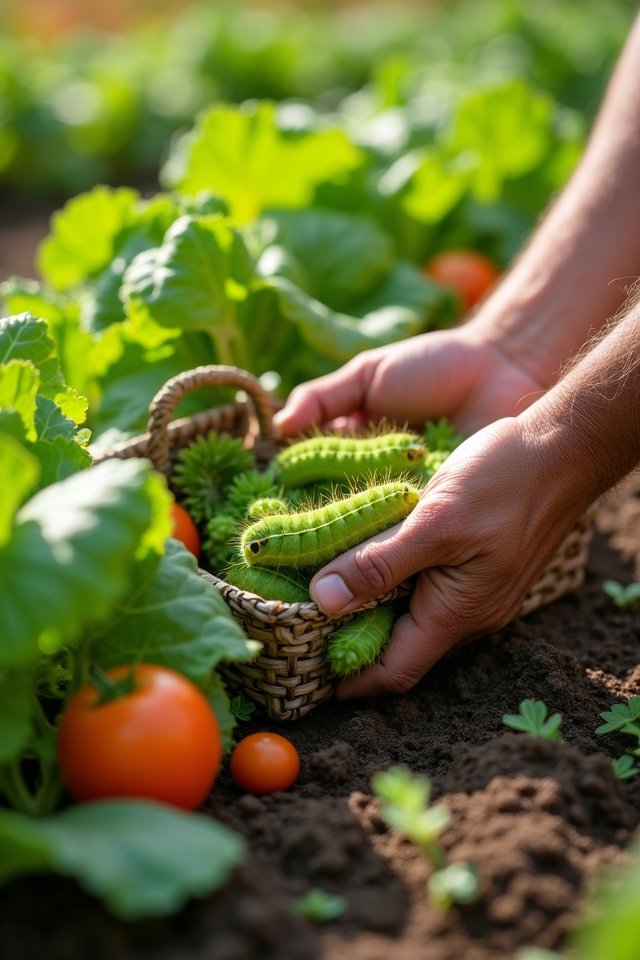
For those days when pests seem to throw a wild party in your garden, handpicking might just be your secret weapon! Imagine strolling through your veggie haven, spotting an aphid or two feasting on your prized tomatoes. Time to spring into action! Start with effective pest identification; grab a jar, and gently collect those party crashers. Don’t be timid—your produce depends on it! Manual techniques like this keep the balance between sustainable gardening and eco-friendly practices. Plus, it’s quite satisfying to evict those pests yourself. Ever feel like a garden superhero? You will! Keeping your plants safe doesn’t require fancy gadgets. Just your keen eyes, steady hands, and a little diligence—you’ve got this! Happy handpicking!
Companion Planting for Pest Reduction

While you might not think your garden could throw a harmonious duet, companion planting can turn it into an orchestra of growth and pest reduction! Imagine pairing tomatoes with aromatic herbs like basil. Not only do they taste fantastic together, but basil also repels pesky pests! You could also plant marigolds alongside your veggies. Those bright flowers are like nature’s bodyguards—keeping aphids and nematodes at bay. Think of plant pairings as a dynamic team, each playing its role to create a breathtaking spectacle. Ever tried planting garlic near your greens? It acts as a natural deterrent for unwanted intruders. With these strategic combinations, your garden will flourish, and you’ll enjoy fresh, homegrown veggies without the pesky nuisances! Happy gardening!
Homemade Organic Sprays and Solutions

Creating your own homemade organic sprays and solutions can be like having a secret garden weapon at your fingertips! Imagine fending off pests with nothing but garlic spray—its pungent aroma sends those pesky insects packing! Just blend a few cloves with water, strain, and spray. Easy, right?
And then there’s neem oil, nature’s little miracle. Mix it with water and a bit of soap to create a potent potion that disrupts pests’ life cycles. Spraying it on your plants not only helps control infestations but also nourishes them!
Physical Barriers: Row Covers and Nets
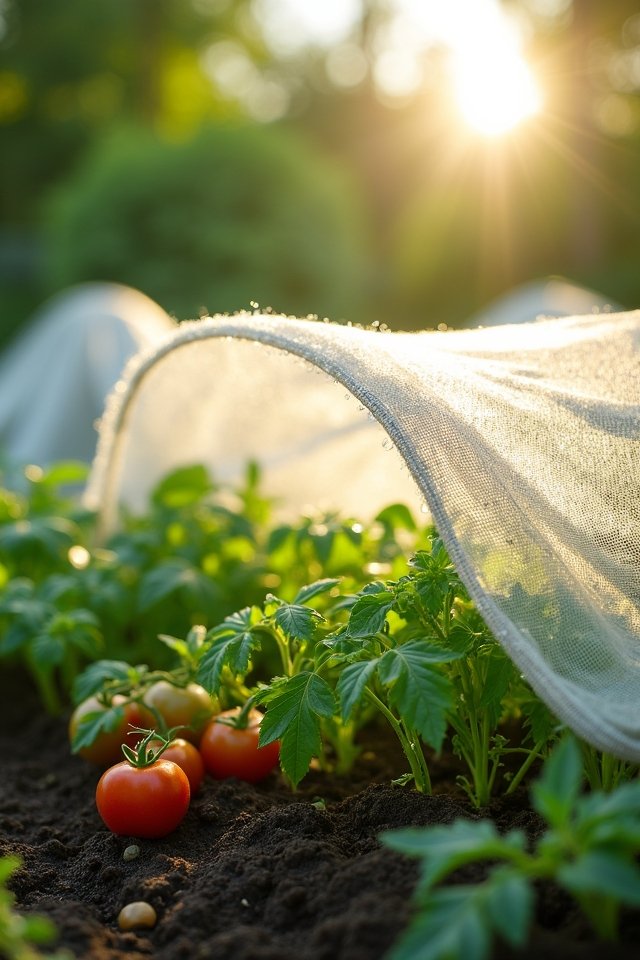
When you’re waging war against garden pests, sometimes it’s best to think outside the box—or in this case, inside a lovely row cover! These magical fabrics can be your secret weapon. Row cover benefits include protection from hungry insects and harsh weather, letting your veggies thrive without constant worry.
Feeling crafty? Try innovative netting techniques to shield delicate plants from sly birds and nimble critters. Whether it’s a floating row cover or a simple mesh net, you’ll turn your garden into an impenetrable fortress! Plus, you can enjoy the sight of your fresh produce flourishing, while pests sulk in defeat. With these barriers, you’re not just gardening—you’re conquering! So go on, give your plants that extra layer of love and protection!
Crop Rotation to Prevent Pest Infestations

Have you ever wondered how to keep those pesky pests on their toes? Crop rotation’s your secret weapon! By shifting your plants around each season, you promote crop diversity, making it tough for pests to settle in. For instance, if you grew tomatoes one year, plant carrots the next—the pests that love tomatoes will be confused! Plus, rotating crops helps maintain soil nutrients, giving your plants a nutrient boost. Imagine your garden thriving with vibrant health, where every plant dances with joy! Not only does it keep critters guessing, but it also enriches your soil, preventing depletion. So, switch things up and watch your garden flourish while pests are left scratching their furry little heads in confusion!
Regular Monitoring and Early Detection
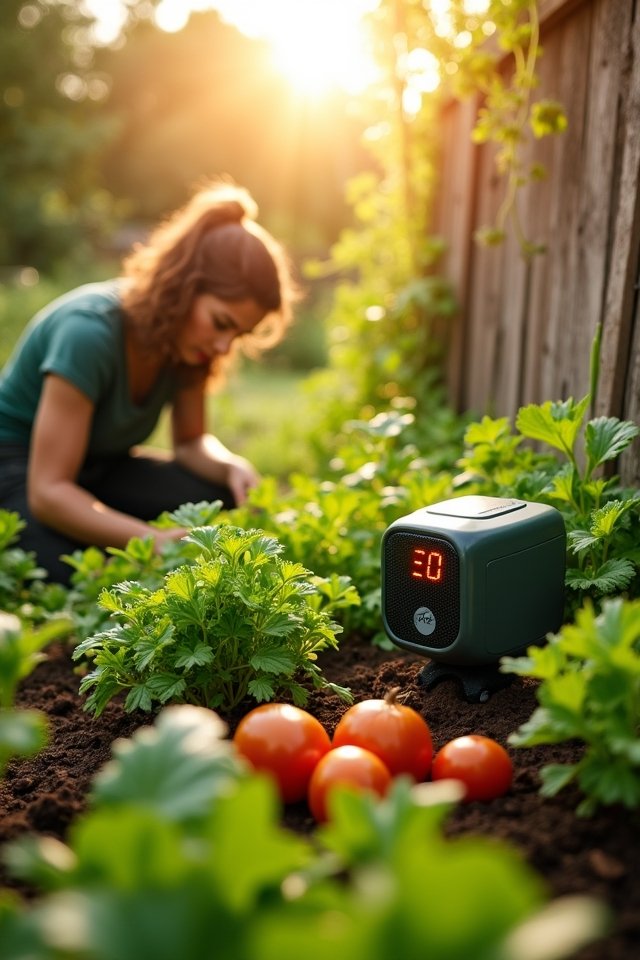
Although pests may seem like tiny ninjas sneaking around your garden, regular monitoring and early detection can be your powerful defense! Imagine this: you stroll through your lush veggies, using keen garden observations to spy those pesky invaders before they wreak havoc. Check under leaves, observe unusual holes, and notice any weird colors—it’s like detective work for your plants! By tracking pest activity daily, you catch problems early and strike before they multiply. Set up traps or sticky cards, and you’ll turn your garden into a pest-free fortress! Don’t let those sneaky critters outsmart you; take charge and safeguard your precious harvest. After all, there’s nothing quite like biting into a pest-free tomato—pure bliss!
Maintaining Healthy Soil and Plant Health
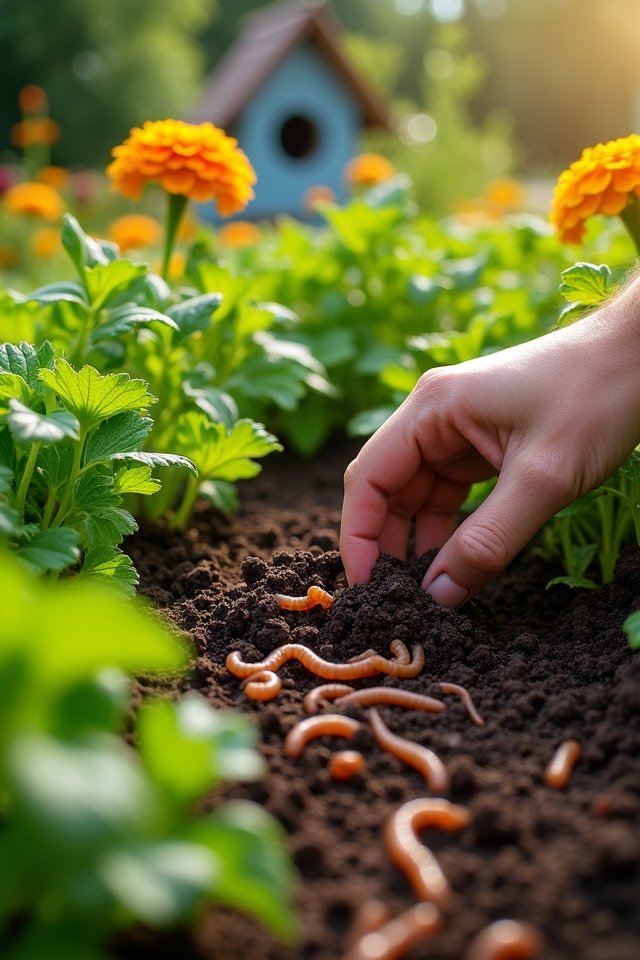
To keep your vegetable garden thriving, think of healthy soil as the secret ingredient to your plants’ happiness! Imagine your garden soil like a sponge, soaking up all the goodness it can. Adding soil amendments, like compost or aged manure, helps enrich it with essential plant nutrients. These vibrant nutrients fuel your veggies, making them robust and ready to take on pests! Have you ever tried a cover crop? They not only protect against erosion but also boost nutrient levels in the soil—what a two-for-one deal! Remember, happy soil means happy plants, and together, they create a lush, bountiful garden. So, let’s dig in and give your plants the nutrient-packed foundation they deserve! Your garden will thank you!
Using Traps for Effective Pest Control
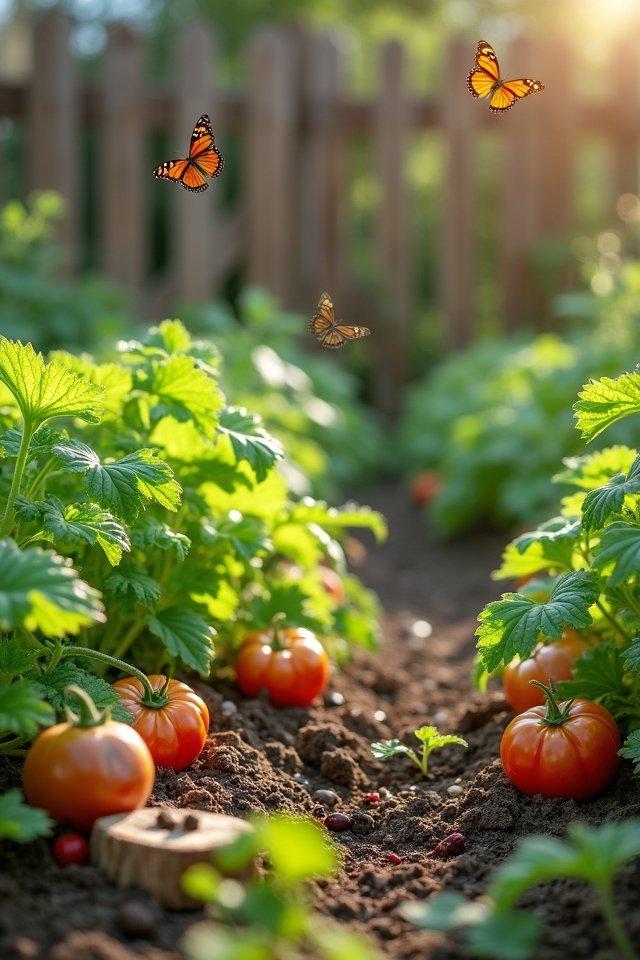
So you’ve got a healthy garden filled with vibrant veggies—now let’s keep those happy plants safe from pesky pests! Using traps is one clever way to outsmart those little invaders. Start by choosing your trap types: sticky traps catch flying nuisances, while bait traps entice sneaky critters that lurk in the shadows. For ideal trap placement, set them near the edges of your garden, those high-traffic areas where pests love to wander. Don’t forget to check your traps regularly—like a diligent gardener on a mission! You’ll feel like a pest control superhero as you monitor pest activity and adjust as needed. With the right traps, you can protect your plants and keep your garden thriving—what a rewarding adventure!
Frequently Asked Questions
What Are the Best Times for Pest Monitoring in Gardens?
Did you know that nearly 30% of garden pests appear at dawn or dusk? That’s why morning inspections and evening observations are key! You’ll catch those sneaky bugs before they wreak havoc. Imagine sipping your coffee while scouting for pests as the sun rises. Talk about a morning thrill! Then, as the sun sets, take another stroll, peering closely at your plants. Trust me, these simple checks can turn your garden into a thriving paradise!
How Do Weather Conditions Affect Pest Populations?
Weather patterns dramatically shape pest cycles! Think of it as nature’s little dance: when it’s warm and humid, pests like aphids throw a party in your garden. When temperatures drop, their numbers dwindle, leaving you with fewer uninvited guests. You’ve got to keep an eye on the skies! So, when rain comes or temperatures fluctuate, stay alert. Your plants deserve a great defense against those little munchers ready to crash the feast!
Can Pets Worsen Pest Problems in Vegetable Gardens?
Did you know that a whopping 60% of pet owners have reported their furry friends attracting pests? That’s right! Pet behaviors—like digging or bringing in dirt—can enhance pest attraction. Imagine cheerful ants marching into your garden, all thanks to your pup’s playful antics! Even a stray fur ball can entice critters. Keep your garden safe by regularly grooming your pets and clearing away their messes; you want veggies, not uninvited guests!
Should I Avoid Certain Plants to Prevent Pests?
Absolutely, avoiding certain plants can help keep pests at bay! Think about companion planting—it’s like giving your veggies a buddy system! For example, marigolds are pest-resistant and can protect your tomatoes like a trusty sidekick. Just like you wouldn’t invite troublemakers to your party, skip plants that attract pests, like cabbage. So, be savvy! By mixing in these friendly varieties, you’ll create a garden that’s both thriving and brave against pesky intruders!
How Do I Identify the Life Stages of Pests?
Identifying the life stages of pests can feel like a detective mission! You’ll want to start with visual identification, looking for tiny eggs, squirming larvae, or those pesky adult pests. Think of them as characters in a pest soap opera! For example, caterpillars munch away like hungry teenagers. Knowing whether it’s an egg or a fully grown pest helps you act decisively. So, get sleuthing, and protect your precious plants from their gnawing drama!


